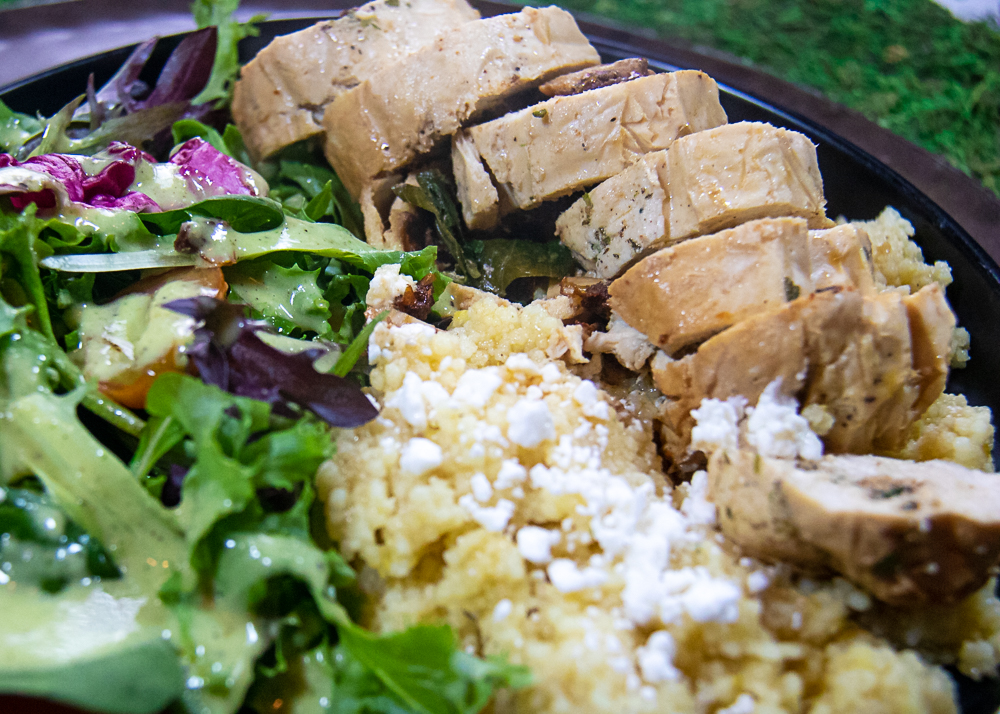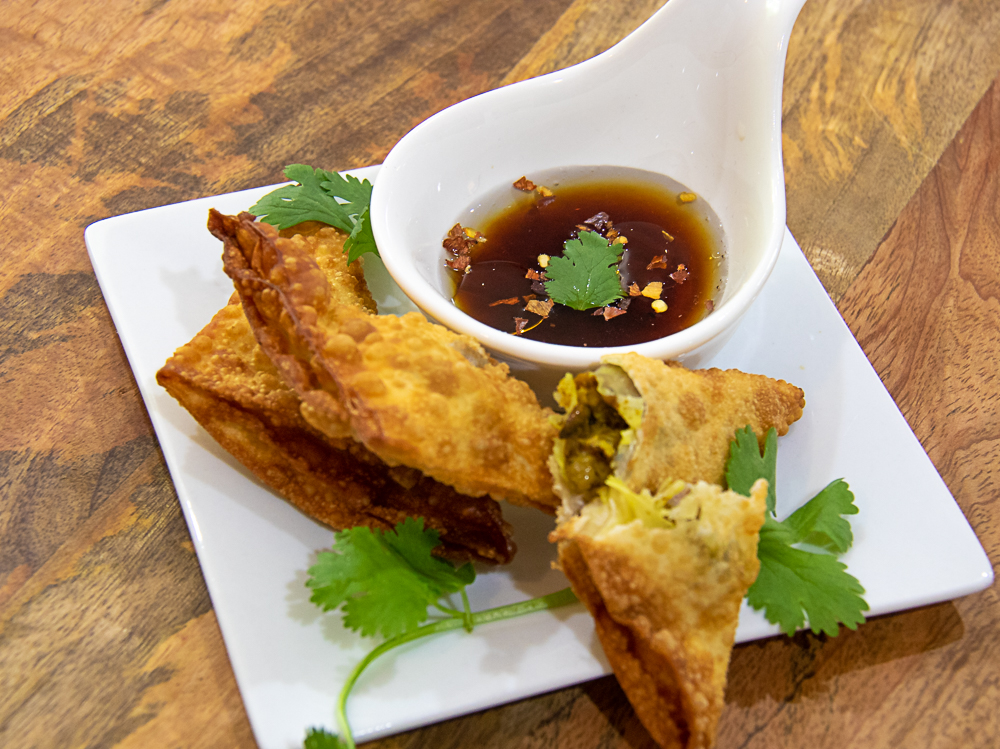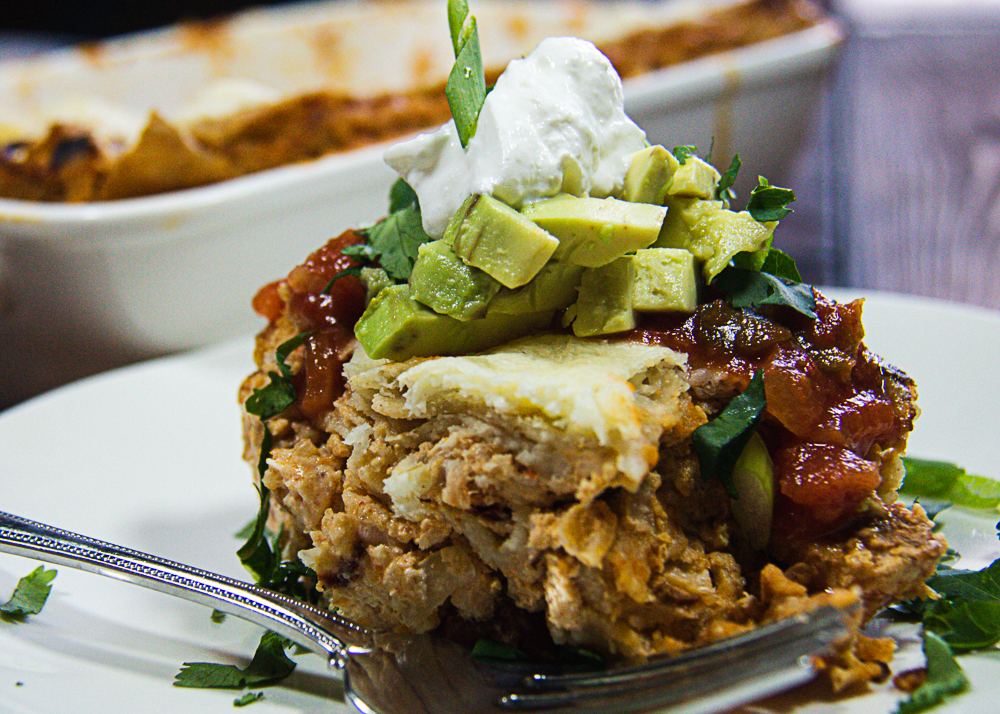
The chimichanga is a restaurant favorite. Whether it is filled with beef, pork, or chicken, this bundle of fried goodness will make your taste buds happy. Chicken Chimichangas with Mexi Sauce are simple to make at home.
While there are recipes for baking the “chimis” instead of frying, I’ve found baking doesn’t crisp up the inner layers of the flour tortilla, so I prefer a shallow fry. When properly done, meaning the oil is at the proper temperature and the pan is not crowded, with this cooking technique foods do not absorb oil when they are fried. So a far superior result than baking with only a minimal amount of oil being absorbed is the way to go.
Chimichangas are basically fried burritos, and while a burrito may be filled with just beans and cheese, chimichangas are filled with some kind of meat, with beans being used as a binder instead of the main attraction.
Origin Story of the Chimichanga
The origins of the chimichanga are of course disputed, but most likely originated in Tucson, Arizona. This city boast as being the “Mexican food Capital of the nation”. (My favorite Mexican restaurant is located in Tucson, and any visit is not complete without a visit to Guadalajaras.)
As the story goes, Monica Flin, owner of EL Charro Cafe, was making a late night snack in the kitchen when a niece she was watching bumped into her and caused her to drop the burrito she was making into a vat of hot oil. Mindful of young ears, she altered the curse she wanted to use into chimichanga instead. Whether the term is a nonsense word like “thingamajig” or it refers to something else. Chimichanga is the name of her creation.
Shallow frying is a term for cooking food in oil that reaches about halfway up the food. (The item being cooked still rests on the bottom of the pan.) Since the oil does not cover the food, it must be flipped to evenly cook. Deep frying is when food is cooked in enough oil that it covers the food and allows the food to float off the bottom of the pan.
Tips for Shallow Frying
- Make sure the oil reaches 350°F-375°F before adding the food. This allows the food to begin sizzling immediately upon touching the oil. The crisp exterior will continue to brown in the oil while also forming a barrier to absorbing excess oil. Use an instant-read thermometer to check the temperature of the oil.
- Use the proper oil. Use vegetable, canola, grapeseed, or peanut oil. These oils have a high smoke point meaning they can reach a high temperature before smoking or burning. Check your oil to make sure it doesn’t smell rancid before using it. The oil that smells off, should be discarded and not used.
- Use the right pan, what you want is a heavy (12-14” is ideal) saute pan with straight or sloped sides, like a cast-iron pan. Non-stick pans aren’t good for shallow frying since the coating prevents browning as thus works against this cooking process.
- Add the proper amount of oil. Add oil to the depth of just over half the depth of the food you are cooking. In most cases this means between 1/2” – 1” of oil in the pan. If you are cooking a lot, you may need to add more oil partway through cooking to maintain that depth.
- Don’t crowd the pan with food. This lowers the temperature of the oil and makes the food steam in oil and water which takes much longer to cook, the lower temperature allows the food to absorb a lot of oil as the water is evaporated and this results in greasy, soggy food.
- Allow the oil to return to the proper temperature. Between each batch of food and after adding oil, wait for the oil to heat to between 350°F-375°F before adding more food. If the oil starts getting too hot, lower the temperature of the burner to maintain that optimal oil temperature.
- Set up the after cook station. Have a paper towel-lined dish (I use several thicknesses of paper towels) to put the cooked food on. This allows excess oil to be whisked away from the food and into the paper towel. This method also keeps the bottom of the food crispier rather than getting soggy from sitting in oil and reabsorbing it.
I like to serve my chimichangas with a Mexi Sauce and then top the whole thing with fresh salsa, guacamole and sour cream.
Print
Chicken Chimichangas with Mexi Sauce
- Prep Time: 15 minutes
- Cook Time: 15 minutes
- Total Time: 30 minutes
- Yield: 12 1x
- Category: entree
- Method: shallow fryied
- Cuisine: Tex Mex
Description
A classic tex-mix dish that is filled with an easy and extremely flavorful chicken filling and topped with a luscious Mexi sauce.
Ingredients
- 1 tablespoon vegetable oil
- 1 onion, diced (about 1 cup)
- 3 cloves garlic, minced (about 1–1/2 teaspoons)
- 3 cups cooked chicken, shredded (you can use a rotisserie chicken)
- 1 jalapeno pepper, finely diced
- 2 teaspoon ground cumin
- 1 teaspoon chili powder
- 1 teaspoon kosher salt
- 1/2 teaspoon smoked paprika
- 1/2 teaspoon black pepper
- 1/4 teaspoon cinnamon
- 4 ounces cream cheese
- 1 (4 ounce) can diced green chiles
- 1 cup refried beans (about 1/2 of a 15 ounce can)
- 1/4 cup cilantro leaves, minced (about 1/3 bunch)
- 2 cups shredded Monterey jack cheese
- 1 package large (10-inch size) flour tortillas
- Oil to shallow fry
Mexi Sauce
- 1 teaspoon vegetable oil
- 1/2 onion, diced (about 1/2 cup)
- 2 garlic cloves, minced (about 1 teaspoon)
- 2 (4 ounce) cans diced green chiles
- 1 teaspoon tomato bouillon
- 1 cup of water
- 1 teaspoon sugar
- 1 teaspoon ground cumin
- 1/2 teaspoon cocoa powder
- 1/4 teaspoon chili powder
- Pinch of kosher salt
- Pinch of black pepper
- 1/4 cup cilantro leaves, minced (about 1/3 bunch)
Instructions
- In a large skillet over medium-high heat, add vegetable oil and saute chopped onion and garlic cloves.
- Add shredded chicken and jalapeño and cook for 2-3 minutes to heat through.
- Stir in the cumin, chili powder, salt, smoked paprika, and black pepper.
- Add the cream cheese, diced green chiles, and refried beans and stir until well incorporated.
- Remove pan from heat and stir in cilantro. Taste and adjust seasoning as desired. Let filling cool for about 5-10 minutes.
- Warm the tortillas in the oven or microwave so they are easier to manipulate.
- Arrange a tortilla on a workspace, place a generous 1/2 cup of filling in the lower middle of the tortilla.
- Sprinkle some Monterey jack cheese on the filling.
- Fold the bottom third of the tortilla up over the filling and hold, fold in the left and right sides to enclose the filling. Roll the bottom of the tortilla with the filling up until the whole wrapper is enclosed and secure the flap with a toothpick. Set aside and repeat with the remaining tortillas.
- In a 12-14” heavy saute pan, add oil to equal just over 1”. Heat oil to 350°F-375°F. This will take 3-5 minutes so be patient and check the oil temperature with a thermometer.
- Prepare a dish with several thicknesses of paper towels.
- When the oil is to temperature, carefully add several chimichangas to the hot oil and fry until golden brown. Using a pair of tongs, turn each chimichanga over and cook the other side until golden brown.
- Remove each chimichanga from the oil when the desired color and allow to cool on the paper towels.
- Allow the oil temperature to rebound to the correct temperature before adding the next batch. Carefully add more oil as needed.
- When all the chimichangas are cooked turn off the heat under the oil and allow the pan and oil to cool completely before discarding the oil in a sealed container.
- Meanwhile, prepare the Mexi sauce by heating 1 teaspoon of vegetable oil in a small saucepan and sauté the onion and garlic until fragrant.
- Add the 2 cans of diced green chiles and cook over medium-high heat for 3 minutes. Add the tomato bullion, water, sugar, cumin, cocoa powder, chili powder, salt, and pepper and cook for 2 minutes more.
- When slightly thickened, transfer sauce to a blender and add the cilantro. Blend until smooth.
- Serve Mexi sauce with the chimichangas and garnish with sour cream, fresh salsa, and guacamole.
Notes
Warming the tortillas before wrapping the chimichangas will make them much easier to work with and less likely to tear.
Remove the toothpick use to secure the chimichangas before serving.
Control the temperature of the oil by turning the heat of oil down if the oil begins to get too hot.
Don’t pour used oil down the disposal to discard it, put it in a sealed container instead.
Nutrition
- Serving Size: 1 chimichanga






Leave a Reply